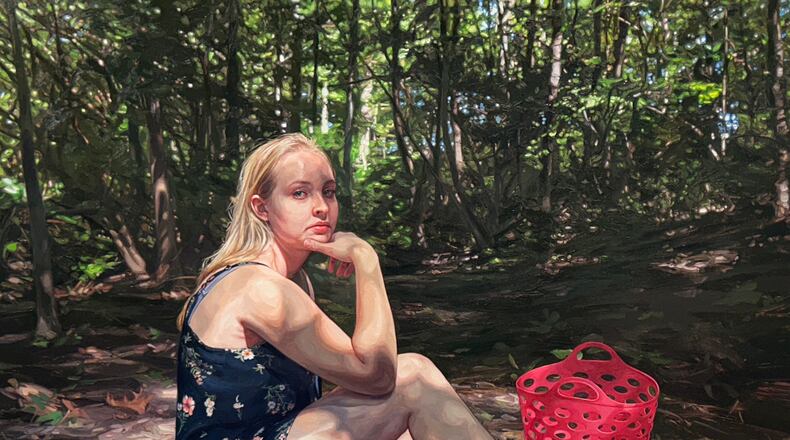Their response is a commentary on the concern of violence toward women — that a bear might harm out of fear or necessity, but that an anonymous man could act indiscriminately out of sexual violence.
If you’re skeptical, ask yourself what your answer would be if the female in the woods was your daughter.
Laura Sanders: Force Of Nature
This mid-career survey currently on view at The Contemporary Dayton, follows the painter’s muse — her daughter Elena — from a young child to an adult woman. As the mostly summertime settings of the paintings evolve over the years, from lakes full of vacationers to an unpeopled forest, so too does the vulnerability of the protagonist, finding herself grown and alone in the woods.
As she matures, the viewer, depending on their own experiences or empathies, may start to worry for her.
Despite this tension, the subject is depicted lovingly with great care to attention of detail. The paintings are stunning and surprising. From a distance they are photorealistic, appearing smoothly blended with every shift of color and depiction of light and shadow. Take a few steps closer and you start to see the lush application of textured paint alive in every nook and cranny of the canvas.
Credit: Hannah Kasper
Credit: Hannah Kasper
“It’s so painterly and technically skilled,” said Heather Jones of the work, which comprises one of three artist shows on display in Jones’ inaugural exhibit as the new Curator and Director of Programs and Engagement at The Co.
“They are photorealistic, but they are also full of tactile abstraction,” said Jones.
Sanders, a Columbus-based artist and a graduate of the Columbus College of Art and Design, takes inspiration not just from the passage of time viewed through the lens of her daughter’s life, but also through nods to art history.
“She’s a master of material and they look very lovely and serene, but when you look into it there is more meaning,” said Jones.
An early swimming series has an Impressionistic quality. Paintings like “Slack Tide” and “Seawater” utilize a high-key color scheme like those in Monet’s “Water Lilies”, which attempted to capture the ever-changing nature of light on water.
Sanders is an artist who, like Monet, seems to chase light. Her faces are often illuminated in dappled sunshine. Themes of floating and weightlessness of a body in water are matched by the lightness of youth and summertime.
These depictions of water speak to the medium of paint itself; the wet, malleable material is used to depict the distorting effects of objects under water — the swirls, bubbles, and ripples of a submerged body in motion. Sanders pays special attention to her daughter’s hair, and in satisfying moments she captures tendrils coiling just beneath the water’s surface.
A shift occurs with “Ground Cover”, 2013, away from the lightness of childhood summer. A bra strap peaks out of a tank top. Girls gossip in front of plastic fencing, seemingly caging them into adolescence.
“When she’s younger she’s claiming that she’s oblivious to the world, and as she’s getting older she is aware of the viewer. It ties in with Laura’s themes of the vulnerability of females in spaces that should be safe,” said Jones.
Credit: Hannah Kasper
Credit: Hannah Kasper
In Sanders’ “Victorine, By Herself”, the subject sits in an identical pose to the model in Edouard Manet’s famous painting “The Luncheon on the Grass”. Chin resting on hand, elbow on raised knee, eyes staring at the viewer.
Manet’s infamous “Luncheon” has been riffed on many times over the centuries. It depicts a nude woman at a picnic alongside two fully dressed men in a rural setting. When it was completed in 1863, it provoked a controversy.
The figure is thought to have been Victorine Meurent, an artist and Manet’s favorite model.
In a recent painting entitled “Cloud Formation”, the subject is grown, and the viewer is presented with a different sort of weightlessness. A plastic water bottle rests by her hand while a mylar balloon floats, untethered, above and away. Is this representative of the fleeting nature of youthful innocence?
Jones says that the references to plastic objects are intentional.
“She deals with environmental concerns so there’s often this addition of plastic in these lush, beautiful landscapes. Water bottles, mylar balloons, (swim) floaties.”
Erin Holscher Almazan: What These Arms Hold
All three artists on view have ties to the region, and all three are mothers.
“I love that it’s a celebration of artists who are mothers, frankly as a mother-artist myself. I didn’t set out to do that, but I’m glad that is the case. (It) carries on The Co’s longstanding tradition of showcasing female artists,” said Jones.
Erin Holscher Almazan is a Professor of Drawing and Printmaking at the University of Dayton. Her new body of paintings on view at The Co examine the separation that occurs as a mother’s children grow up, becoming more independent with time.
All works are oil on paper, full of expressionist color and gestural brushstrokes, with a very different feel than the work of Sanders’, though there is cross-over in the subject matter.
These paintings are rendered in tones of violet, blue and sepia. They are figurative, focusing only on a single body in each piece. Hands are featured, motifs that “symbolize both care and release”. The compositions combine fully rendered areas with more sketch-like components.
Credit: Hannah Kasper
Credit: Hannah Kasper
Paintings in the “Let Down” series are impactful in what first strikes the viewer as either sensual or uncomfortable touch. The term “let down” refers both to the tingling and painful sensation a breastfeeding mother experiences when her milk comes in, as well as the artist’s experiences of middle age and her changing body.
“You won’t remember this, but I always will” is a series of three paintings of an anonymous figure’s arms and hands cradling an empty space where an infant may once have been held. Of all the pieces they most objectively symbolize a sense of loss. For the artist, it may be the loss associated with her own children growing up and no longer needing the direct care she once offered. For others, it may strike a more somber tone. It is estimated that at least 20% of pregnancies end in miscarriage.
Christine Gaffney: Well-Balanced
Christine Gaffney is an interdisciplinary artist who lives in the Dayton region and recently received her Master of Fine Arts from the California Institute of the Arts. Gaffney’s sculptures and videos act as intimate self-portraits and reflections of the complexities and dualities in female identities.
While Sanders’ and Holscher Almazan’s themes relate directly to motherhood, Gaffney’s is not explicitly linked to mothering as such. However, there are themes of domesticity, and a commentary on the mother’s body and psyche made visible. The videos are sometimes perplexingly raw, but Jones says there is, again, more than meets the eye.
“She’s not interested in perfection or the classical norms of painting and sculpture. She embraces those imperfections. The microphone is gargled, there are weird edits,” said Jones of the two videos on display.
Credit: Contributed
Credit: Contributed
In “When I Wonder”, Gaffney records herself speaking for 13 minutes about her art practice, but edits out all complete thoughts. This leaves the viewer to hear only the pauses, hesitations, and filler words, and glean nothing directly of what she has to say about her own work.
The result is uncomfortable — cringey, it seems to convey a lack of confidence. With direction that references either an interview or an art school critique, Gaffney stares off at the same focal point, which is not where a person would be behind a camera. Instead, she seems to gaze off into the distance, not making eye contact. Is she talking to herself? Does she know what she’s saying? There is a disconnect with reality.
She appears bare-faced and naked from the shoulders up, both vulnerable yet not afraid to confront the viewer with her refreshingly real body.
Jones calls this awkward dialogue a reflection of “the in-between, liminal spaces.”
Perhaps Gaffney is challenging the authority of the person on the other side of the camera — whether that be an interviewer, professor, or the spectator in the gallery.
The Bear
The wonderful thing about thinking critically about art is that one discovers there is much more than meets the eye. Exhibitions at The Co invite you to peel back the onion; look past the face value of these artworks — whether that is aesthetic beauty and skill of rendering, or what appears to be imperfection. Art can be dissected, informed by history, current events, or subjective experience, to reveal layers of depth.
Therefore, all the words above could just be a biased perspective coming from this writer, a woman and a mother, whose own daughter is catapulting towards adolescence. So, I’ll break the fourth wall to let you know this: I would choose the bear.
HOW TO GO
What: The Contemporary Dayton, current exhibits
When: May 16-Aug. 23
Where: 25 W. 4th St., Dayton
Contact: (937) 224-3822 and codayton.org
ARTIST TALKS
Laura Sanders: 6:30 p.m. June 26
Erin Holscher Almazan: 6:30 p.m. July 10
Christine Gaffney: 6:30 p.m. July 24
About the Author




